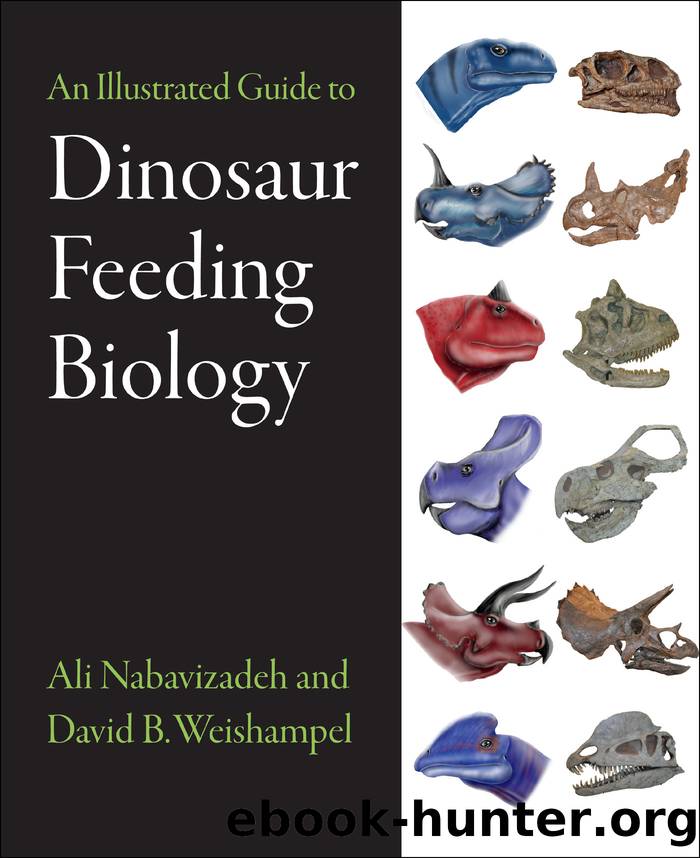An Illustrated Guide to Dinosaur Feeding Biology by Nabavizadeh Ali;Weishampel David B.;

Author:Nabavizadeh, Ali;Weishampel, David B.;
Language: eng
Format: epub
Publisher: Johns Hopkins University Press
Published: 2023-06-15T00:00:00+00:00
Heterodontosauridae
For reference in understanding relationships and clade affiliation of early ornithischians discussed in this chapter, see the phylogeny (fig. 10.1) and taxon list (table 10.1) below.
According to phylogenetic analyses by Butler et al. (2008), Heterodontosauridae is among the earliest-diverging clades within Ornithischia. Heterodontosaurids ranged from the Early Jurassic to Early Cretaceous and had nearly worldwide distribution. The skulls of heterodontosaurids (e.g., Heterodontosaurus [fig. 10.2], Tianyulong, Echinodon, Pegomastax, Fruitadens, Abrictosaurus, and Manidens) are generally no larger than the palm of your hand and possess a deep occiput with a midline sagittal crest that extends from just behind the orbits to the caudal edge of the skull roof. Heterodontosaurids have a triangular snout with large orbits and antorbital fossae. A dorsally arched notch is present at the premaxillary-maxillary junction, where a caniniform (i.e., âcanine-likeâ) fang from the corresponding region of the dentary rests inside at occlusion. Otherwise, the tooth-bearing regions of the maxilla and dentary sit parallel to one another at occlusion. Typically, the heterodontosaurid dentition consists of small premaxillary teeth, one caniniform tooth at the mesial end on the dentary resting just caudal to those premaxillary teeth at occlusion, and a row of precisely occluding âhypsodontâ cheek teeth (adapted for constant wearing) with flat oblique occlusal surfaces (Norman et al., 2011; see below). Their temporal region (and supratemporal fenestra) was rostrocaudally broad and transversely narrow, and the postorbital adductor region and infratemporal fenestra are subrectangular and vertically oriented. The palate of heterodontosaurids is broad, with a moderately sized pterygoid flange.
Figure 10.1. Phylogeny of early Ornithischia, largely based on Butler et al. (2008) and Boyd (2015).
Download
This site does not store any files on its server. We only index and link to content provided by other sites. Please contact the content providers to delete copyright contents if any and email us, we'll remove relevant links or contents immediately.
Sapiens: A Brief History of Humankind by Yuval Noah Harari(13089)
The Tidewater Tales by John Barth(12040)
Do No Harm Stories of Life, Death and Brain Surgery by Henry Marsh(6346)
Mastermind: How to Think Like Sherlock Holmes by Maria Konnikova(6260)
The Thirst by Nesbo Jo(5804)
Why We Sleep: Unlocking the Power of Sleep and Dreams by Matthew Walker(5668)
Sapiens by Yuval Noah Harari(4561)
Life 3.0: Being Human in the Age of Artificial Intelligence by Tegmark Max(4526)
The Longevity Diet by Valter Longo(4458)
The Rules Do Not Apply by Ariel Levy(3920)
The Immortal Life of Henrietta Lacks by Rebecca Skloot(3838)
The Body: A Guide for Occupants by Bill Bryson(3831)
Why We Sleep by Matthew Walker(3784)
Animal Frequency by Melissa Alvarez(3764)
Yoga Anatomy by Kaminoff Leslie(3718)
Barron's AP Biology by Goldberg M.S. Deborah T(3640)
The Hacking of the American Mind by Robert H. Lustig(3591)
All Creatures Great and Small by James Herriot(3531)
Yoga Anatomy by Leslie Kaminoff & Amy Matthews(3414)
